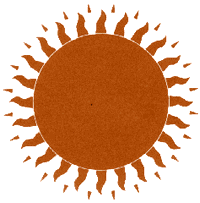Containing no corrosive chemicals, giving off no pollution and able to generate electricity indefinitely just by lying in the sun, solid state photocells -- commonly known as "solar batteries" -- are a promising source of safe energy. Projects under way at the Weizmann Institute may spur the wider use of these environmentally benign devices.
In one of them, a novel photoetching technique for modifying the surface of silicon has been developed by Prof. Reshef Tenne and co-workers in collaboration with French researchers. Their approach increases the efficiency of silicon photocells by reducing the amount of light they reflect and by limiting "surface recombination," the trapping of electrons in the semiconductor before they can exit as an electric current.
An inexpensive new method for removing problematic transition-metal impurities from semiconductors has also been designed by Prof. Tenne. Here, an infra-red laser is used to ionize impurity atoms, causing their rapid movement through the semiconductor and enabling their removal from the crystal surfaces by simple chemical procedures. This technique may find numerous economically feasible applications for improving photovoltaics of various kinds.
A novel photovoltaic cell, operating on a principle differing radically from that underlying standard photocells, has been devised by Dr. Gary Hodes. The cell is made of easily produced films of semiconductor nanocrystallites which are less than one-hundredth the size of the crystallites present in standard photovoltaics.
Hodes, collaborating with Tenne, is also designing solar cells containing thin films of layered, well-ordered semiconductors such as molybdenum disulfide and tungsten diselenide -- materials that are far more stable than widely used amorphous silicon.
In other work, a theoretical approach has been developed by Dr. David Cahen that explains why pre-heating polycrystalline solar cells in air helps reduce energy-conversion losses due to decreased current loss on crystallite surfaces. Cahen has also succeeded in identifying and analyzing the basic mechanisms by which solar energy is lost as heat in solar cells, and in measuring such losses experimentally. In addition, working with Drs. Lev Margulis and Gary Hodes, he showed that thermal mismatch between components of solar cells made of polycrystalline thin films is a major problem in the manufacture and performance of such cells; the scientists went on to demonstrate that this mismatch can be virtually eliminated by using a cheaper type of glass as substrate for the cell.
Cahen has also collaborated with Prof. Amnon Yogev, who heads a project in which highly concentrated sunlight is split into two different parts (spectral ranges), one used to drive solar powered lasers and the other converted into electricity by "concentrator" solar cells. Experiments are now under way to convert all of the concentrated sunlight into electricity by splitting it into a number of spectral ranges, each matched to a different type of solar cell.
Some of these Institute developments are already being closely examined by solar cell manufacturers in Europe.

